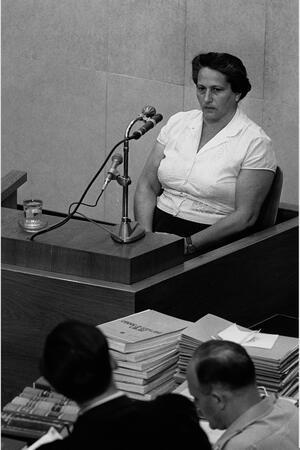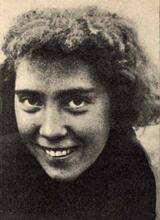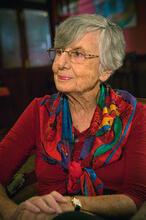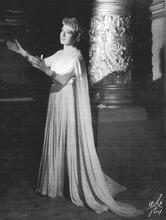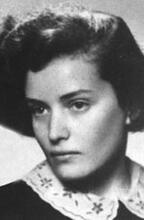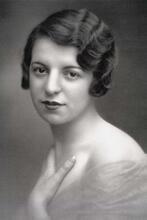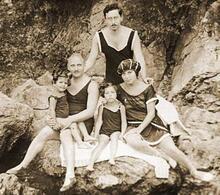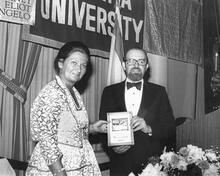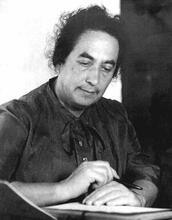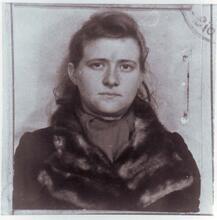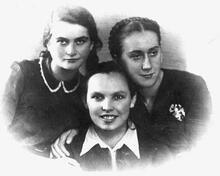Hansi Brand (Hartmann)
A Zionist activist in Hungary during the Holocaust, Hansi Hartmann was born in 1912 and married Joel Brand in 1935. After the annexation of Austria in March 1938, the couple became involved in helping Jewish refugees who had escaped to Hungary. After Joel left to give information to Zionist leadership in 1944, Hansi became a prominent member of The Relief and Rescue Committee, which Joel had founded in 1942. She was a key figure in “The Rescue Train,” the most important project in which the committee was involved. After the war, she emigrated to Palestine and in 1961 she served as a witness at the Eichmann Trial, giving testimony that made a great impact both on the trial and on the State of Israel.
Early Life
A Zionist activist in Hungary during the Holocaust, Hansi Hartmann was born on August 26, 1912, in Budapest and was educated there. During her high-school studies she joined a Zionist youth movement and, later, a pioneering village that provided Jewish youth with agricultural training prior to their immigration to Palestine. There she met Joel Brand, who was born in 1906 in Naszód (Transylvania) and educated in Germany, where he was an active member of the KPD (The Communist Party in Germany). In 1934 he was deported from Germany by the Nazi regime and returned to Transylvania, settling in Budapest.
In 1935 Hansi married Joel Brand in Budapest. Though initially this was a fictitious union conducted in order to obtain a certificate of immigration into Palestine, it later became a real marriage. The couple had two sons, one of whom died young. They opened a small glove factory in which both Joel and Hansi worked. In addition, Joel was a prominent member of the World Union of Mapai.
Wartime Activities
After the annexation of Austria by Germany in March 1938, the couple became involved in helping Jewish refugees who had escaped to Hungary, deepening their involvement in rescue in summer 1941. When Hansi’s sister and her family were deported to Poland, the couple tried to save them by bribing Jozef Krem, an officer of the Hungarian intelligence. In 1942, together with Rezso Rudolf (Israel) Kasztner (1906–1957) and Samuel Springmann, Joel founded The Relief and Rescue Committee, which aimed at smuggling Jews from Slovakia and Poland to the relative safety of Hungary. Hansi was a leading member of the new committee and during her work in it became a close friend of Israel Kasztner.
On March 19, 1944, Germany invaded Hungary and the SS started preparing the process of the Final Solution. Hungary was the last country in this process and the SS worked very quickly. In March 1944 there were eight hundred thousand Jews in Hungary; by July 1944 about four hundred thousand Jews had been deported to Auschwitz.
The members of the Committee tried to rescue Hungarian Jewry, negotiating with the Jewish Unit of the SS, headed by Adolf Eichmann, regarding a deal, later named “Blood for Goods” which involved stopping the annihilation of Hungarian Jewry in exchange for ten thousand trucks that would be used only against the Eastern Front.
On May 19 Joel flew to Istanbul in order to present the SS proposal to the Zionist leadership and, through them, to the West. When he left Budapest Hansi became a prominent member of the committee. In fact, she and Kasztner were its leaders, since not only her husband but also Springmann had left, emigrating to Palestine in January 1944, before the German invasion.
Hansi Brand and Kasztner were key figures in the most important project in which the committee was involved: “The Rescue Train.” On June 30, 1944, a train left Budapest carrying 1,685 Jews. They reached Bergen-Belsen and from there traveled to Switzerland. The train was like Noah’s Ark; the passengers were representative of all sectors of Hungarian Jewry: from the Ultra-Orthodox to the Zionists; from the right-wing Revisionist party to the left-wing Ha-Shomer ha-Za’ir. Hansi Brand was a major figure in the special committee that chose those who left Hungary on that train.
She herself and her two young sons did not escape from Hungary on it. She continued to remain active in the Committee’s rescue activities, one of which rescued fifteen thousand Jews, who were deported to Strasshof concentration camp near Vienna instead of to Auschwitz. In November 1944 about fifty thousand Jews were forced by the Germans and the Hungarian Gendarme to march from Budapest to the Austrian border. Most of the people died during this “Death March.” Hansi tried to save the children who were on it.
Postwar Life
Brand stayed in Budapest after the end of the war. In 1946 she reached Switzerland. She testified before a special committee that dealt with Kasztner’s activity during the Holocaust in Hungary, which held its deliberations in Basel in December 1946, during the twenty-second Zionist Congress.
In 1947 she emigrated to Palestine, living with her family on A voluntary collective community, mainly agricultural, in which there is no private wealth and which is responsible for all the needs of its members and their families.kibbutz Givat Hayyim and after a couple of years they moved to Tel Aviv.
As a witness during the Kasztner Trial in 1954, she spoke about the nature of the rescue activity which took place in Budapest during the war. During the trial her friendship with Kasztner, which had become less intense after the war, was again strengthened. In 1961 she served as a witness at the Eichmann Trial, giving testimony which made a great impact both on the trial and on the State of Israel. After the trial she collaborated with her husband in writing The Devil and the Soul, which deals with their activities and fate during the Holocaust and the Kasztner Trial.
Joel Brand died in 1964 at the age of fifty-eight, a middle-aged man broken by his experience with the “Blood for Goods” mission, the Kasztner trial and the Eichmann trial.
Hansi Brand died on April 9, 2000, in Tel Aviv.
Bauer, Yehuda. Jews for Sale? Nazi-Jewish Negotiations 1933-1945. New Haven: Yale University Press, 1994.
Brand, Hansi and Joel Brand. Satan and the Soul. Israel: Ladori, 1960.
Geva, Sharon. To the Unknown Sister: Holocaust Heroines in Israeli Society. Tel Aviv: Hakibbutz Hameuchad, 2010.
Geva, Sharon. "Wife, Lover, Woman: The Image of Hansi Brand in Israeli Public Discourse." Nashim 27 (2014): 97–119.
Weitz, Yechiam. The Man who was Murdered Twice: The Life, Trial and Death of Israel Kasztner. Jerusalem: Keter, 1995.

